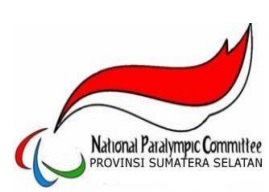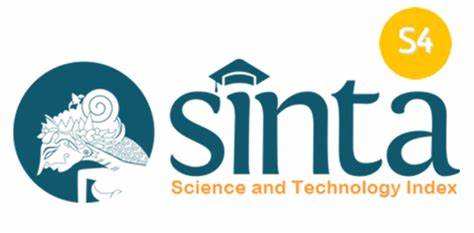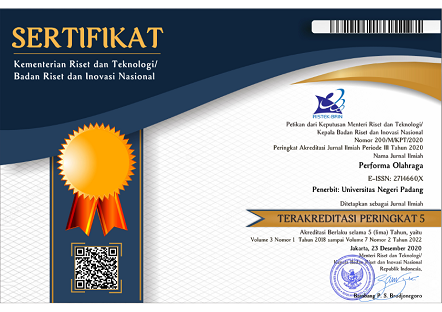Gamification in Physical Education Learning: A Strategy to Increase Student Participation at Universitas Terbuka
Keywords:
Gamification, Online Learning, Physical EducationAbstract
This study seeks to evaluate how gamification affects student motivation, engagement, and learning in an online Physical Education course at Universitas Terbuka. A sample of 40 out of 240 students enrolled in the 4th semester of the program was drawn using purposive sampling. The participants responded to a 12-item acknowledgment scale measuring four aspects of gamification: motivational aspects of games, participation and engagement, skills, and overall learning experiences. Based on the analysis of the data collected, findings point out that gamification positively affects student motivation and participation. A significant number of students (92.5%) agreed that new activities based on games made learning processes more enjoyable, and 90% of students said that gamification lessened the boredom encountered in online learning. Although underperforming students were able to increase their understanding of theoretical concepts taught in class, there was a lack of improvement in the performance of some students who were active in independent physical skill practice with only 75% agreeing that the tasks fostered the development of independent physical skills. Most of the students supported the continuation of gamification in the Physical Education course and 95% wanted the inclusion of more game-oriented learning in future lessons. The results indicate that although gamification increases motivation and participation, other strategies are needed to develop practical skills in the context of online Physical Education classes.
References
Alsharif, M. (2022). Integrating digital devices and (social media) applications during lecture time in a Saudi University: Students’ and lecturers’ views on blended synchronous approaches. The University of Liverpool (United Kingdom). https://search.proquest.com/openview/3f5424bdd127462e58deb4b0a25ced91/1?pq-origsite=gscholar&cbl=2026366&diss=y
Brown, J. M. (2021). The Feedback Phenomenon: A Study of Principals’ Perceptions of Receiving Feedback from Teachers. University of South Dakota. https://search.proquest.com/openview/0eb1c87416e1fa653b9623cce207012c/1?pq-origsite=gscholar&cbl=18750&diss=y
Chen, Y., & Zhao, S. (2022). Understanding Chinese EFL learners’ acceptance of gamified vocabulary learning apps: An integration of self-determination theory and technology acceptance model. Sustainability, 14(18), 11288. https://doi.org/10.3390/su141811288
Chou, Y. (2019). Actionable gamification: Beyond points, badges, and leaderboards. Packt Publishing Ltd. https://books.google.com/books?hl=id&lr=&id=9ZfBDwAAQBAJ&oi=fnd&pg=PP5&dq=The+term+gamification+refers+to+the+incorporation+of+certain+game+design+elements+like+points,+badges,+challenges,+leaderboards,+and+rewards+&ots=xvjXHUYOFJ&sig=9PdCoyL5McwX2Q44QqBd9syVsxk
Christopoulos, A., & Mystakidis, S. (2023). Gamification in education. Encyclopedia, 3(4), 1223–1243. https://doi.org/10.3390/encyclopedia3040089
Dichev, C., Dicheva, D., Angelova, G., & Agre, G. (2015). From Gamification to Gameful Design and Gameful Experience in Learning. Cybernetics and Information Technologies, 14(4), 80–100. https://doi.org/10.1515/cait-2014-0007
Elsayed, H., Nivala, M., & Carlzon, L. (2024). Students’ and Instructors’ Perspectives on Learning and Professional Development in the Context of Interprofessional Simulation. Teaching and Learning in Medicine, 36(4), 454–469. https://doi.org/10.1080/10401334.2023.2230562
Howard-Hamilton, M. F., Morelon-Quainoo, C. L., Johnson, S. D., Winkle-Wagner, R., & Santiague, L. (2023). Standing on the outside looking in: Underrepresented students’ experiences in advanced degree programs. Taylor & Francis. https://books.google.com/books?hl=id&lr=&id=rg_JEAAAQBAJ&oi=fnd&pg=PT7&dq=Perhaps+one+of+the+more+enduring+problems+associated+with+distance+learning+is+low+student+engagement+and+participation,+especially+acute+when+dealing+with+subjects+that+are+predominantly+practice-oriented,+such+as+Physical+education+&ots=ZEIiii_btG&sig=TOrMROnf98X17WxIF2P_kOD_R9w
Jones, I. (2022). Research methods for sports studies. Routledge. https://www.taylorfrancis.com/books/mono/10.4324/9781003195467/research-methods-sports-studies-ian-jones
Jones, M., Blanton, J. E., & Williams, R. E. (2023). Science to practice: Does gamification enhance intrinsic motivation? Active Learning in Higher Education, 24(3), 273–289. https://doi.org/10.1177/14697874211066882
Kapp, K. M. (2013). The gamification of learning and instruction fieldbook: Ideas into practice. John Wiley & Sons. https://books.google.com/books?hl=id&lr=&id=NaYzAQAAQBAJ&oi=fnd&pg=PR21&dq=Kapp+(2012)+that+gamified+learning+experiences+are+often+regarded+as+captivating+by+learners&ots=Wi66Zcsfwc&sig=DL-nYafAaXF8VvEGwIxYzST0YSY
Karra, S., Karampa, V., & Paraskeva, F. (2019). Gamification Design Framework Based on Self Determination Theory for Adult Motivation. In L. Uden, D. Liberona, G. Sanchez, & S. Rodríguez-González (Eds.), Learning Technology for Education Challenges (Vol. 1011, pp. 67–78). Springer International Publishing. https://doi.org/10.1007/978-3-030-20798-4_7
Kim, M., Knotts, T. L., & Albers, N. D. (2022). Hands-on activity vs. High-tech tools in the higher education classroom to improve student satisfaction and loyalty in professional programs. Education and Information Technologies, 27(9), 12147–12177. https://doi.org/10.1007/s10639-022-11124-2
Kong, Y., Zhu, X., Yang, Y., Xu, H., Ma, L., & Zuo, Y. (2024). Knowledge, attitudes, practice, and public health education demand regarding PARI prevention: A cross-sectional study among Chinese undergraduates. Frontiers in Public Health, 12, 1387789.
McHaney, R. (2023). The new digital shoreline: How Web 2.0 and millennials are revolutionizing higher education. Taylor & Francis. https://books.google.com/books?hl=id&lr=&id=4g_JEAAAQBAJ&oi=fnd&pg=PA1969&dq=The+primary+characteristics+of+online+education:+its+convenience,+availability,+and+flexibility+make+it+an+attractive+option,+especially+for+multi-tasking+learners+who+are+in+remote+locations+and+are+trying+to+balance+education+with+personal+and+professional+obligations&ots=I5x9NNIQgo&sig=lAithioeH9XpQIF1Rmv70OH0Tl4
Nzala, A. (2021). Student Experiences of Emergency Remote Learning and Teaching During COVID-19. https://open.uct.ac.za/handle/11427/36555
Parks, K. R. (2023). A Phenomenological Study of Teachers’ Experiences with Educational Gamification and its Impact on Student Engagement in the Middle School Math and Science Classroom. https://digitalcommons.liberty.edu/doctoral/4786/
Rahayu, F. S., Nugroho, L. E., Ferdiana, R., & Setyohadi, D. B. (2022). Motivation and engagement of final-year students when using e-learning: A qualitative study of gamification in pandemic situation. Sustainability, 14(14), 8906. https://doi.org/10.3390/su14148906
Sailer, M., Hense, J., Mandl, H., & Klevers, M. (2017). Fostering Development of Work Competencies and Motivation via Gamification. In M. Mulder (Ed.), Competence-based Vocational and Professional Education (Vol. 23, pp. 795–818). Springer International Publishing. https://doi.org/10.1007/978-3-319-41713-4_37
Saleem, A. N., Noori, N. M., & Ozdamli, F. (2022). Gamification Applications in E-learning: A Literature Review. Technology, Knowledge and Learning, 27(1), 139–159. https://doi.org/10.1007/s10758-020-09487-x
Skinner, J., Smith, A. C., Read, D., Burch, L. M., & Mueller, J. (2024). Research methods for sport management. Routledge. https://www.taylorfrancis.com/books/mono/10.4324/9781003397335/research-methods-sport-management-james-skinner-aaron-smith-daniel-read-lauren-burch-jacqueline-mueller
Thomas, J. R., Martin, P., Etnier, J. L., & Silverman, S. J. (2023). Research methods in physical activity. Human kinetics. https://books.google.com/books?hl=id&lr=&id=JEhtEAAAQBAJ&oi=fnd&pg=PR1&dq=descriptive+survey+approach++in+sport+book&ots=0n-LNoxiwX&sig=F26tkZlw0V49x6o10NrmfsvUwkQ
Tyack, A., & Mekler, E. D. (2024). Self-Determination Theory and HCI Games Research: Unfulfilled Promises and Unquestioned Paradigms. ACM Transactions on Computer-Human Interaction, 31(3), 1–74. https://doi.org/10.1145/3673230
Xu, J., Du, H. S., Shen, K. N., & Zhang, D. (2022). How gamification drives consumer citizenship behaviour: The role of perceived gamification affordances. International Journal of Information Management, 64, 102477. https://doi.org/10.1016/j.ijinfomgt.2022.102477
Yang, H., & Li, D. (2021). Understanding the dark side of gamification health management: A stress perspective. Information Processing & Management, 58(5), 102649. https://doi.org/10.1016/j.ipm.2021.102649
Yang, Y., Yu, A., Li, J., Shafi, M., & Fauzi, M. A. (2024). Exploring the impact of gamified elements on college students’ learning in virtual learning communities. Kybernetes. https://doi.org/10.1108/K-01-2024-0017
Zichermann, G., & Cunningham, C. (2011). Gamification by design: Implementing game mechanics in web and mobile apps. O’Reilly Media, Inc. https://books.google.com/books?hl=id&lr=&id=Hw9X1miVMMwC&oi=fnd&pg=PR7&dq=The+term+gamification+refers+to+the+incorporation+of+certain+game+design+elements+like+points,+badges,+challenges,+leaderboards,+and+rewards+&ots=0tljbn7vso&sig=npE4JsmrNOSeg4HaPQwoTe87bmo
Downloads
Published
How to Cite
Issue
Section
License
Copyright (c) 2025 Mudayat Mudayat

This work is licensed under a Creative Commons Attribution-NonCommercial-ShareAlike 4.0 International License.









.png)





